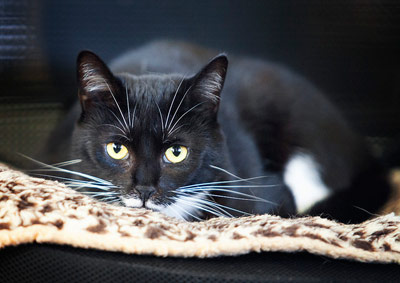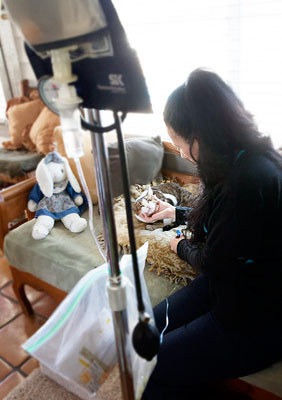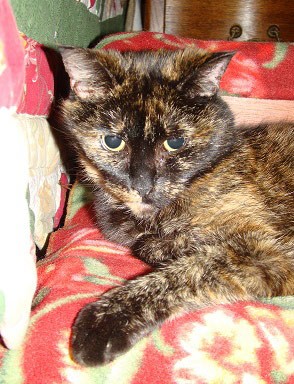Pain

Pain and suffering and their impact on quality of life are the issues most often used to determine the proper time for euthanasia. Oftentimes that outcome is right and the only course of action, but very often animals can live on in comfort and dignity if pain is expertly controlled in palliative care.
Many times I have heard that cats and dogs do not feel pain as we humans do, but modern research is now showing that animals and humans have similar, if not identical, neural pathways for the development, conduction and modulation of pain, as indicated in the 2015 AAHA/AAFP pain management guidelines for cats and dogs.
Therefore, it appears that we must make our own judgment based upon our animals’ behavior and apparent need. Will to live is another important consideration. If in any doubt, one should seek advice from a professional in whichever field of medicine one has chosen to follow.
Find a place (inside) where there’s joy, and the joy will burn out the pain. –Joseph Campbell
Our discussion of pain in the context of animal hospice and the dying process would therefore not be complete without a brief look at pain as part of life in general. It is important to keep in mind that pain is a symptom of a “something.” Here’s a simple analogy: If we chop off a finger we feel terrible pain, even possibly faint right away, but we are not euthanized. We work proactively to relieve the pain.
Pain is a natural part of our lives from the moment we begin our physical existence, as evidenced by the process of human childbirth. Both mother and child experience pain, yet we do not equate this pain with suffering. Instead, we recognize this painful process as a natural part of our physical existence, just as we do the various painful physical injuries we experience as we grow older (skinned knees, bumps, bruises, headaches, etc.).
As with birth, so too is some pain a natural part of the dying process if pain has been part of the disease leading to death. For all beings, be they human or animal, it is in many ways as much a struggle to leave this world as it is to enter it. Yet for the most part, we humans equate the dying process with extreme suffering – a manifestation of our own fear of the unknown. We have found, however, that through the use of natural medicine, and the gradual elimination of drugs, the dying process can be a peaceful one, and we realize that much of the perceived pain is more a manifestation of what is going on within us than with the animals.
Frequently Asked Questions About Pain
Q How can pain be identified?
A Animals sometimes do not show pain, and so the first priority is to identify its presence and degree as accurately as possible. Some signs might be changes in behavior, personality or appetite; reactivity to touch in affected areas; dilated pupils.
We have learned that death itself is not painful but that disease causes pain, so it may be that those dying of a disease rather than old age experience pain that requires pain control.
Q How can the level of pain be determined?
A Perhaps the best way to evaluate pain levels is to look at how a symptom is expressed. For example, some expressions of these changes could be the inability to jump or walk well, limping; lethargy; discomfort; hiding; panting; open-mouthed breathing; vocalizing; restlessness; screaming.
Q Are these the aches and pains of old age, or do they need addressing?
A It is always good to consult a qualified veterinarian for advice. Sometimes a change in diet, or treatment by homeopathy or acupuncture or other form of energy medicine can make a world of difference.
Q How can I help?
A Remain calm, soothing and loving. Do not panic. Work with your veterinarian and other practitioners on your hospice team to mitigate the animal’s pain. Holistic approaches including flower essences, essential oils and Reiki may help.
Q How do I deal with my own emotional pain?
A Breathe, focus on living in the moment and do your best to let go of your fears.
Q Does untreated pain affect the quality of life?
A Yes, it does, and that is why we must be proactive.
Q Does pain always need managing?
A Good question! Ask the animal…From BrightHaven’s perspective, it is the physical body that is dying – not their true essence, or soul. Severe pain always needs treatment, but very often pain may not need managing and will be temporary. However, drugs are regularly prescribed due to the fear of pain by the human without taking into account the wisdom of Mother Nature’s perfection of the dying process.
Q Does the presence of pain warrant euthanasia?
A This is a personal decision to be made if pain cannot be controlled, and should be based upon the facts and the animal and not the person’s discomfort or pain.
Q Humans faint if experiencing awful pain. Can animals do the same thing?
A Mother Nature provided fainting as an escape from pain and yes, animals may “step out” or away from their physical bodies. They return, we believe, when the level of pain is less.
Q Is there ever a downside to administering drugs?
A Once drugs are given, very often they are continued as no one knows when, if or how to stop since ongoing pain is assumed. The suppression of symptoms may not always be the best thing. One must die of “something” and when symptoms are heavily suppressed, other issues can be triggered rather than allowing for the body’s natural progression to its demise.
Meet two BrightHaven animals who undoubtedly conquered their pain:

Harley
Our 800 lb. paraplegic, Reiki-loving pig who was determined to live forever! Read Harley’s Story

Patti
A gorgeous German Shepherd who feared cats and yet spent her last weeks as a paraplegic, surrounded by feline love! Read Patti’s Story
Palliative Care

What is Palliative Care?
We’ve listed a few characteristics of palliative care:
- Comfort care aimed at relieving and soothing symptoms and pain rather than achieving a cure
- Medical care or treatment that concentrates on reducing the severity of disease symptoms, rather than striving to stop, slow down, delay, or reverse progression of the disease itself or provide a cure
- Supportive treatment that focuses on physical, psychological and spiritual needs
- Treatment that can help the patient live more comfortably
- Specialized care provided by a team of professionals
Palliative care goes hand-in-hand with hospice care and is very important for the patient’s day-to-day comfort.
BrightHaven’s philosophy embraces palliative care in our regimen but we continue to seek healing (balance) all the way to end of life.
Palliative Care at BrightHaven

BrightHaven uses classical veterinary homeopathy as our principal form of healing. We continue to offer homeopathic care to the very end of life, as we view healing as essential for continued life as well as for transition. Remedies stimulate the body to heal itself and we firmly subscribe to the belief that, while the body is able to express its out-of-balance state by producing symptoms, it is still able to heal. So if symptoms are present, we are still treating, and if symptoms are not present and death is imminent, then there will be no need to treat. Hence, no symptoms indicate no pain or suffering…This approach could be one key to the magic that is BrightHaven.
On the rare occasion when we cannot get a good response from homeopathic remedies or Reiki, we then evaluate the need for palliative drugs, particularly for managing pain. In human and animal hospice care the taking of drugs can lead to a buildup of toxicity in the system, which in turn may accentuate feelings of nausea and sickness and can also lead to premature loss of appetite and often depression, both physically and mentally. A distinct fogginess of mind and spirit often occurs.
As a patient’s body becomes more toxic and s/he is unable to eat or be active, then it is understandable that a veterinarian may pronounce their inability to do more to help the animal – often leading to an understandable (and possibly premature) recommendation for euthanasia.

Another thing to keep in mind: BrightHaven’s experience has been that less drugs in the system at end of life often correlates to a gentler death.
Animals possess an inherent understanding of the circle of life and death. Therefore, sometimes palliation (mitigation) of symptoms actually offers palliation for the guardian, when in fact the animal may have no need. A sweeping statement! Let us enlarge upon it as we discuss quality of life and suffering.
The great art of life is the sensation, to feel that we exist, even in pain. –Lord Byron
Knowledge reduces fear and increases confidence, and conscious decision-making may minimize future regrets. We invite you to explore our caregiver resources (including animal hospice education and holistic healthcare education), online learning and publications to learn more. You may also wish to book a consultation with BrightHaven President and Founder Gail Pope.



